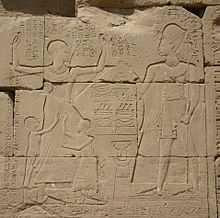Amenhotep (High Priest of Amun)
| Amenhotep High Priest of Amun | |
|---|---|
|
Amenhotep, high priest of Amun | |
| Predecessor | Ramessesnakht |
| Successor | Piankh or Herihor |
| Dynasty | 20th Dynasty |
| Pharaoh | Ramesses IX, Ramesses X, Ramesses XI |
| Father | Ramessesnakht |
| Mother | Adjedet-Aat |
| Burial | TT 58 (P&M, I-1, 1994, p. 119) |
Amenhotep was the High Priest of Amun towards the end of the Twentieth Dynasty of Egypt, serving under Ramesses IX, Ramesses X and Ramesses XI. He was also vizier, or great confidant, to his master and was first prophet of Amun-resonther. He was the son of Ramessesnakht, the previous high priest of Amun.[1]

During the reign of Ramesses XI, the Viceroy of Nubia Pinehesy attacked Thebes and besieged the high priest at the fortified temple of Medinet Habu. [2][3]
During the first decades of the 20th century there was much confusion about both the date of the suppression and the role of Pinehesy. Whereas an early Egyptologist as Wilhelm Spiegelberg assumed that it was Amenhotep himself who rebelled, Sethe showed that Amenhotep was the victim rather than the oppressor. More often than not the suppression was placed in the reign of Ramesses IX or in the early years of Ramesses XI. It is now commonly accepted that the suppression took place only shortly before the Whm Mswt, the era which started in year 19 of Ramesses XI.
It is not known for certain whether the High Priest, Amenhotep, survived this attack. However, Wente published a heavily damaged inscription from Karnak in which a High Priest (name lost, but almost certainly Amenhotep) looks back at a period of suppression. The text is highly suggestive of Amenhotep having been restored to his former position after an appeal to the king. [4]
In 1962 G. Fecht published the theory that Papyrus Moscow 127, popularly known as the "Tale of Woe" or the "Letter of Wermai" was in fact a Roman à clef, containing veiled references to the suppression of Amenhotep by the Viceroy Pinehesy, with the name Wermai interpreted as a word play on a similar sounding pontifical title.[5] If Fecht is right, the Tale of Woe provides additional evidence that Amenhotep returned to office.
Nesamun
The Second Prophet of Amun Nesamun, a brother of Amenhotep, also lays claim to the position of High Priest of Amun. He does so in an inscription on the base of a statue of his father Ramessesnakth.[6] However, he can neither have preceded nor succeeded his brother:
-during the first phase of the pontificate of Amenhotep it was a certain Tjanefer who is attested as Second Prophet of Amun, showing that Nesamun only became prominent later.[7]
-in the famous Oracle of year 7 of the Whm Mswt Nesamun is still presented as Second Prophet, together with the High Priest of Amun Piankh.[8] However, it has been pointed out that Piankh more or less stands aside while Nesamun fulfills the role normally played by the acting High Priest.[9]
It has been postulated that Nesamun may have acted as 'temporary' High Priest to replace his brother during the Suppression of the latter by the Viceroy of Kush Pinehesy.[10] Such a scenario might explain why he was apparently allowed by the High Priest Piankh to perform the role normally played solely by the High Priest of Amun.
Further reading
- Spiegelberg, W. Die Empörung des Hohenpriesters Amenhotpe unter Ramses IX, ZÄS 58 (1923), 47-48
- Sethe, Kurt. Die angebliche Rebellion des Hohenpriesters Amenhotp unter Ramses IX, ZÄS 59 (1924), 60-61
- Peet, T. Eric. The Supposed Revolution of the High-Priest Amenhotpe under Ramesses IX, JEA 12 (1926), 254-259
- Fecht, G. Der Moskauer "literarische Brief" als historisches Dokument, ZÄS 87 (1962), 12-31
- Thijs, Ad. The Troubled Careers of Amenhotep and Panehsy: The High Priest of Amun and the Viceroy of Kush under the Last Ramessides, SAK 31 (2003), 289-306
References
| Wikimedia Commons has media related to Amenhotep, High priest of Amun. |
- ↑ "High Priests of Amun".
- ↑ Morales, A. J., "The Suppression of the High Priest Amenhotep: A Suggestion to the Role of Panhesi", Göttinger Miszellen 181 (2001), 59–75.
- ↑ Niwinski, A., "Bürgerkrieg, militärischer Staatsstreich und Ausnahmezustand in Ägypten unter Ramses XI. Ein Versuch neuer Interpretation der alten Quellen", in Gegengabe Brunner-Traut, 235–262
- ↑ Edward F. Wente, "The Suppression of the High Priest Amenhotep", Journal of Near Eastern Studies 1966
- ↑ G. Fecht, Der Moskauer "literarische Brief" als historisches Dokument, ZÄS 87 (1962), 12-31
- ↑ CGC 42162; G. Legrain, ASAE 6 (1905), 133
- ↑ T.O. Bács, GM 148 (1995), 9-11; Ad Thijs, SAK 38 (2009), 346
- ↑ Nims, JNES 7 (1948), 157-162.
- ↑ L. Bell, Serapis 6 (1980), 44
- ↑ Ad Thijs, The Second Prophet Nesamun and his claim to the High-Priesthood, Studien zur Altägyptischen Kultur (SAK) 38 (2009), 343-353.